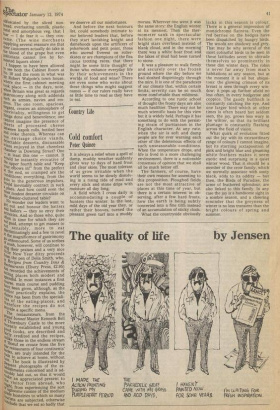Country Life
Cold comfort
Peter Quince
It is always a relief when a spell of damp, muddy weather suddenly gives way to days of hard frost and clear skies. The most tolerant of us grow irritable when the world seems to be slowly dissolving in a rising tide of mud and every stick and stone drips with moisture all day long. A field which I cross daily is accommodating a couple of hunters this winter. In the last, mild days of the old year they, or rather their hooves, turned the pleasant green turf into a muddy morass. Wherever one went it was the same story: the English winter at its messiest. Then the thermometer sank in spectacular fashion one night, there were bright stars overhead instead of blank cloud, and in the morning there was a white hoar frost and the lakes of mud had been turned to stone.
It was a pleasure to walk firmly and securely over the frozen ground where the day before we had sloshed dispiritingly through the mire. It is one of the paradoxes of our climate that, within certain limits, severity can be so much more comfortable than mildness.
According to one rustic school of thought the frosty days are also much healthier. There may not be much scientific basis for this view but it is widely held. Perhaps it has something to do with the persisting strain of puritanism in the English character. At any rate, when the air is soft and damp people are for ever warning each other of the deleterious effects of such unseasonable conditions. When the temperature drops, and life is lived in a more challenging environment, there is a noticeable consensus of opinion that we shall all be much better off.
The farmers, of course, have their own reasons for assenting to this proposition. Ploughed fields are not the most attractive of places at this time of year, but there is a certain interest 'in observing, after a few hard frosts, how the earth is being subtly converted into a fine tilth instead of an accumulation of sticky clods.
What the countryside obviously lacks in this season is colour. There is a general impression of monochrome flatness. Even the red berries on the hedges have been dispatched by hungry birds. The woods are shadowy and grey. That may be why several of the most colourful birds to be seen in these latitudes seem to obtrude themselves so prominently in these dim winter days. The robin is never far away from man's habitations at any season, but at the moment it is all but ubiquitous: the glowing crimson of its breast is seen through every window; it pops up further afield no less often, in every hedgerow and coppice. The gaudy bullfinch is constantly catching the eye. And one larger bird which at other times is often heard but seldom seen, the jay, grows less wary in the winter, so that its brilliant plumage is constantly flashing across the field of vision.
What quirk of evolution fitted out the jay with its extraordinary range of colours I cannot imagine, but its startling juxtaposition of pink and bright blue and gleaming white feathers makes it seem exotic and surprising in a quiet winter wood. That it should be a member of the crow family, which we normally associate with sooty black, adds to its oddity — but then, the Birds of Paradise, the acme of feathered splendour, are also linked to this family. In any case the jay is a handsome sight in a sombre season, and a cheering reminder that the greyness of winter is no less transient than the bright colours of spring and summer.


































 Previous page
Previous page